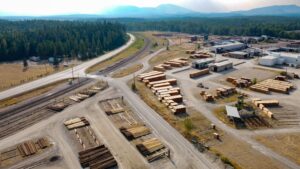92% of construction projects now require verified EPDs – yet many steel suppliers still rely on outdated, manual reporting. Environmental Product Declarations (EPDs) standardize and clearly communicate the life cycle impacts of steel products, streamlining compliance with regulatory frameworks such as LEED v4 and Buy Clean legislation. This article breaks down exactly how EPD steel enables manufacturers and sustainability professionals to automate emissions tracking, achieve trusted certifications, and efficiently meet rigorous green building demands. Here’s how your team can modernize carbon data workflows – and meet rising expectations with confidence.
Understanding EPD Steel: What is an Environmental Product Declaration for Steel?
An Environmental Product Declaration (EPD) provides transparent, standardized data on the environmental impacts of steel products throughout their lifecycle – from raw material extraction to manufacturing, transportation, usage, and recycling or disposal. For steel producers and construction professionals, EPDs deliver comprehensive, verified information that supports informed decision-making about sustainability and compliance.
At its core, an EPD for steel is built on a Life Cycle Assessment (LCA), a detailed analysis that quantifies environmental impacts across specific, standardized categories. These typically include:
– Carbon Footprint: Total greenhouse gas emissions (measured in CO₂ equivalents) generated throughout the steel product lifecycle.
– Energy Usage: Amount of energy consumed during each phase, broken down by renewable and non-renewable sources.
– Resource Efficiency and Recyclability: Data on recycled content, recyclability at end-of-life, and overall material efficiency.
Steel EPDs play a critical role in meeting regulatory compliance and supporting green building initiatives. Certifications such as LEEDv4, as well as procurement guidelines from Buy Clean legislation, frequently require verified EPD documentation to demonstrate a product’s environmental credentials.
By clearly outlining steel’s lifecycle impacts, EPDs also enable companies to pinpoint specific areas for sustainability improvements – helping manufacturers reduce emissions, optimize energy usage, and increase resource efficiency. For decision-makers aiming to achieve net-zero targets or comply with regulatory frameworks, understanding and leveraging EPD steel documentation is an essential step toward transparent, measurable environmental impact management.
How EPD Steel Supports Regulatory Compliance and Green Building Standards

Environmental Product Declarations (EPDs) for steel offer verified, transparent environmental impact data crucial for meeting regulatory frameworks and green building standards. By clearly quantifying emissions and other environmental metrics, EPD steel documentation assists manufacturers and supply chain managers in aligning with strict industry requirements, such as LEEDv4 certification and Buy Clean legislation.
Compliance with regulatory frameworks for steel emissions demands precise, standardized reporting. EPDs fulfill these requirements by systematically presenting data collected through comprehensive Life Cycle Assessments (LCAs), covering the entire production lifecycle from raw material sourcing through manufacturing and recycling. For steel plants, adhering to recognized EPD reporting guidelines ensures transparency, accuracy, and comparability of environmental performance data – essential components for regulatory compliance.
Sustainable steel certifications, increasingly sought by construction professionals and sustainability officers, require the presence of independently verified EPDs. Programs such as ResponsibleSteel and GreenStar specifically mandate detailed, third-party validated environmental declarations as proof of sustainability performance. Verified EPDs not only confirm adherence to global standards for EPD in steel construction but also establish credibility with stakeholders, investors, and regulatory bodies.
EPD steel documentation helps organizations navigate evolving legislation such as the EU’s Construction Products Regulation (CPR), the California Buy Clean Act, and other international green procurement policies. By providing clear evidence of environmental stewardship and carbon footprint management, EPDs simplify compliance reporting and position companies to respond proactively to sustainability trends and market demands.
Key benefits of EPD steel documentation include:
– Facilitates compliance with LEEDv4 and global green building certifications.
– Provides robust evidence for regulatory reporting, such as emissions disclosure under Buy Clean frameworks.
– Supports achievement and verification of sustainable steel certifications recognized industry-wide.
– Enhances stakeholder trust through independently verified environmental performance data.
Incorporating EPD steel into your sustainability strategy ensures streamlined regulatory compliance, positions your products favorably in green procurement processes, and strengthens your organization’s overall sustainability profile.
## Lifecycle Assessment of Steel Products: The Foundation of EPD Steel
Life Cycle Assessment (LCA) forms the scientific backbone for Environmental Product Declarations (EPDs) in steel production. LCA systematically quantifies the environmental impacts associated with every stage of a steel product’s lifecycle – from raw material extraction and production to transportation, utilization, and end-of-life recycling or disposal.
Performing an LCA involves robust methodologies aligned with international standards (ISO 14040 and ISO 14044). These methodologies ensure consistent, transparent, and reliable environmental impact quantification in steel. The LCA process typically consists of four distinct phases:
1. Goal and Scope Definition: Clearly defining the study’s purpose, product system boundaries, functional units, and data requirements to ensure accurate, meaningful comparisons.
2. Inventory Analysis: Compiling comprehensive data about material inputs, energy usage, emissions, and waste outputs throughout each lifecycle stage. For steel products, this includes tracking resources such as iron ore, recycled scrap steel, energy inputs (renewable and non-renewable), and manufacturing processes.
3. Impact Assessment: Translating inventory data into measurable environmental impacts across standardized categories. Typical categories for steel include:
– Global warming potential (carbon footprint)
– Acidification potential
– Eutrophication potential
– Ozone depletion potential
– Resource depletion (minerals and fossil fuels)
4. Interpretation and Reporting: Evaluating the results, identifying areas of significant environmental impact (“hotspots”), and recommending strategies for reduction and improvement.
Upon completion, the LCA results serve as the foundational data for creating EPD steel documentation. EPDs summarize these detailed findings into standardized, transparent declarations that clearly communicate a product’s environmental performance. By leveraging robust LCA methodologies, steel manufacturers ensure their EPDs meet regulatory compliance, provide transparent environmental disclosures, and facilitate informed decision-making for sustainability officers and supply chain managers.
Analyzing EPD Steel: Key Environmental Metrics and Performance Benchmarks
Environmental Product Declarations (EPDs) for steel provide essential data that allows sustainability officers and supply chain managers to evaluate and compare steel products’ environmental impacts clearly and consistently. By quantifying specific metrics, EPDs facilitate informed decision-making, regulatory compliance, and measurable sustainability improvements.
Typical environmental metrics covered in EPD steel analysis include:
– Carbon Emissions: The total greenhouse gases emitted throughout a steel product’s lifecycle, measured in tonnes of CO₂ equivalents.
– Energy Consumption: The amount of energy required to produce steel, differentiated into renewable and non-renewable sources.
– Recycled Content: The proportion of recycled materials utilized in steel production.
– Recyclability: The percentage of steel products that can be effectively recycled at end-of-life stages.
EPDs also offer comparative analyses of these metrics across different steel production methods, highlighting substantial differences in environmental performance depending on the chosen technology. For example, carbon emissions vary significantly according to the steel manufacturing route:
| Steel Production Method | CO₂ Emissions (tonnes per ton of steel) |
| Blast Furnace (BF) | 2.25 – 2.8 |
| Electric Arc Furnace (EAF) | 0.62 – 0.85 |
| Direct Reduced Iron (DRI) | 1.12 – 1.35 |
These variations underscore the value of using EPDs to benchmark steel products and assess the environmental footprint across different suppliers or manufacturing methods. Companies aiming for net-zero targets or compliance with frameworks like LEED v4 or Buy Clean legislation can leverage EPD steel data to pinpoint opportunities for emission reductions and improved environmental performance.
Beyond emissions, comparative analysis of steel environmental metrics can reveal insights into resource efficiency and circularity. For instance, steel produced using electric arc furnaces typically utilizes significantly higher recycled content compared to blast furnace methods, resulting in measurable improvements in resource efficiency and reduced energy consumption.
By systematically tracking and benchmarking these performance metrics, companies can clearly identify areas for improvement, demonstrate sustainability progress to stakeholders, and meet stringent regulatory and industry standards.
## Sustainable Innovations and Decarbonization Strategies in EPD Steel Production
To meet aggressive sustainability targets, the steel industry is implementing innovative decarbonization strategies validated through Environmental Product Declarations (EPDs). Current decarbonization roadmaps aim for a global CO2 emissions reduction of 25% by 2030, with European targets set even higher at 35%. Achieving these goals requires widespread adoption of advanced sustainable practices, renewable energy integration, and circular economy principles.
One critical strategy involves transitioning from traditional blast furnace methods to electric arc furnaces (EAFs) and direct reduced iron (DRI) processes, significantly lowering emissions. Using renewable hydrogen (green hydrogen) in place of fossil fuels represents a major innovation trend, enabling steel mills to drastically cut CO2 output. Additionally, increasing the proportion of scrap and recycled steel in production cycles aligns directly with circular economy models, reducing reliance on virgin resources and decreasing environmental impact.
Innovative carbon capture and utilization technologies further complement these approaches. For example, recent pilot projects have introduced microbial bioreactors that effectively convert captured CO2 emissions into renewable fuels, creating additional value streams and reducing overall carbon footprints. Coupled with the integration of renewable energy sources like wind and solar, these eco innovations have achieved significant emission reductions in steel manufacturing – bringing CO2 emissions down to approximately 0.3–0.4 tonnes per ton of steel produced.
EPDs play a crucial role in documenting and verifying these advancements. By transparently quantifying reductions in carbon emissions and resource usage across the product lifecycle, steel manufacturers can demonstrate compliance with stringent regulatory requirements and communicate sustainability improvements clearly to stakeholders. Through strategic approaches to steel decarbonization, renewable energy integration, and circular economy practices, the steel industry continues to make tangible progress toward net-zero targets.
Digital Solutions for Streamlined EPD Steel Management and Reporting
Managing Environmental Product Declarations (EPDs) for steel requires precise, reliable data tracking and reporting to meet stringent sustainability standards. Next-generation software for steel sustainability streamlines this complex process by automating data collection, ensuring real-time reporting capabilities, and enhancing digital traceability in steel carbon reporting.
Advanced digital management of steel environmental data simplifies compliance with industry standards and regulatory requirements. By centralizing all lifecycle data – from production processes to transportation and recycling – digital solutions significantly reduce manual effort and minimize reporting errors. This automation provides accurate, consistent environmental metrics that directly support compliance requirements, including LEEDv4 certification and Buy Clean legislation.
Innovative software platforms offer clear advantages:
– Real-time data tracking: Immediate insights into steel production emissions and resource consumption, enabling quick responses to sustainability challenges.
– Enhanced transparency: Auditable data trails that build stakeholder trust and facilitate regulatory reporting.
– Improved accuracy: Automated data collection reduces human error, ensuring reliable reporting that aligns with recognized EPD frameworks.
– Efficient compliance workflows: Streamlined, standardized reporting that saves time and resources compared to manual methods.
By leveraging digital solutions, sustainability officers and supply chain managers can confidently track, analyze, and report steel environmental performance, meeting evolving regulatory expectations and demonstrating measurable progress toward sustainability targets.
Best Practices for Creating and Verifying EPD Steel Documentation
Creating credible Environmental Product Declarations (EPDs) for steel requires adherence to robust, standardized processes and clear verification protocols. To ensure your EPD steel documentation meets industry expectations and regulatory compliance, follow these proven best practices:
1. Use Transparent Methodologies:
Clearly define your Life Cycle Assessment (LCA) scope, system boundaries, and data collection processes. Transparency in methodologies enables stakeholders to understand how environmental impacts were calculated, fostering trust and reliability.
2. Robust Data Collection:
Collect comprehensive, verifiable data from every relevant lifecycle stage – raw materials, manufacturing processes, transportation, usage, and end-of-life recycling or disposal. Accurate, detailed data ensures that your EPD accurately reflects real-world environmental impacts.
3. Standardized Impact Categories:
Compile your LCA data into standardized impact categories, such as global warming potential, ozone depletion, acidification, eutrophication, and resource depletion. Aligning with universal industry standards (ISO 14025, EN 15804) ensures comparability and regulatory acceptance.
4. Independent Third-Party Verification:
Engage independent verifiers accredited by recognized certification bodies to thoroughly review and validate your EPD documentation. Third-party verification confirms compliance with global standards and enhances your EPD’s credibility in the market.
5. Lifecycle Transparency:
Clearly present lifecycle stages, assumptions, and exclusions within your EPD. Lifecycle transparency allows sustainability officers, procurement professionals, and regulatory bodies to confidently evaluate your steel products against certification criteria for green steel products and regulatory requirements.
By following these best practices, steel manufacturers can produce standardized, transparent, and trustworthy environmental declarations that fulfill certification criteria and support strategic sustainability objectives.
Industry Insights: Case Studies Demonstrating the Value of EPD Steel
Implementing Environmental Product Declarations (EPDs) in steel production delivers tangible environmental and economic benefits, as demonstrated by multiple industry case studies.
One compelling example is a bridge project in France, which originally planned for traditional concrete construction. By shifting to a steel composite structure guided by detailed EPD data, the project achieved a reduction of emissions by 12.5%, significantly lowering its overall carbon footprint. Such a substantial emissions reduction demonstrates clearly how EPD-driven decisions enhance sustainability outcomes and align effectively with regulatory compliance frameworks.
In another notable example, sheet piling solutions manufactured from recycled steel showed impressive environmental cost savings. Compared to conventional steel production methods, these recycled steel sheet piles achieved an 83% reduction in carbon emissions. This dramatic improvement highlights how EPD steel facilitates informed choices, enabling manufacturers and construction firms to significantly reduce their environmental impacts and meet stringent sustainability targets.
The economic benefits of steel decarbonization are equally impactful. Companies leveraging EPD steel practices experience considerable cost advantages through streamlined regulatory compliance, reduced environmental mitigation expenses, and enhanced brand reputation. Adopting sustainable steel solutions positions businesses competitively in the marketplace, appealing to increasingly sustainability-conscious investors and customers.
Key measurable outcomes from these best practice case studies include:
– 12.5% carbon emissions reduction through optimized steel composite bridge structures.
– 83% lower emissions from recycled steel sheet piling compared to traditional steel solutions.
– Reduced compliance costs and improved market competitiveness for firms actively utilizing EPD steel data.
These industry examples underscore EPD steel’s dual benefits in driving sustainability progress and delivering measurable economic value, making it a strategic imperative for companies committed to environmental excellence and competitive advantage.
Final Words
Environmental Product Declarations for steel offer transparency and measurable insights into the environmental impacts of steel products – from lifecycle assessment metrics to performance benchmarks and decarbonization innovations.
Leveraging digital solutions makes EPD steel management more practical than ever, enhancing accuracy and compliance with sustainability regulations and global green building standards.
With robust reporting practices in place, steel producers and users alike can confidently pursue low-carbon options, positioning themselves as leaders in sustainable construction and manufacturing.
Adopting epd steel is a powerful step toward a more sustainable, transparent, and resilient industry.
FAQs on EPD steel
Q: What is an EPD in steel?
A: An Environmental Product Declaration (EPD) for steel provides standardized, transparent data summarizing the material’s environmental impacts. It details impacts like carbon emissions and energy usage based on comprehensive Life Cycle Assessments (LCAs).
Q: What does EPD stand for?
A: EPD stands for Environmental Product Declaration, a verified document offering standardized information on a product’s lifecycle environmental impacts, critical for informed decision-making and meeting regulatory requirements.
Q: What’s the difference between ISO 14067 and an EPD?
A: ISO 14067 specifically addresses methodologies for calculating a product’s carbon footprint, whereas an EPD provides a broader, standardized report covering multiple environmental impacts, including carbon emissions, recyclability, and energy consumption.
Q: What does it mean for steel to be EPD certified?
A: Steel products labeled EPD certified indicate their environmental impacts have undergone independent verification, which ensures data transparency, supports sustainable purchasing decisions, and meets criteria under green building standards like LEEDv4.
Q: How does EPD steel help meet compliance with green building standards?
A: Utilizing EPD steel documentation ensures compliance with standards such as LEEDv4 and Buy Clean legislation, fulfilling the necessary regulatory criteria for transparent environmental disclosure and aiding sustainable construction certifications.
Q: Which environmental performance metrics are included in steel EPDs?
A: Typical metrics covered in steel EPDs include carbon emissions, energy consumption, recycled content percentages, and recyclability. These metrics enable informed choices, accurate sustainability comparisons, and benchmark industry progress.
Q: How do digital solutions improve management of EPD steel data?
A: Digital platforms streamline the collection, analysis, and real-time reporting of steel’s environmental performance. They enhance accuracy, traceability, and transparency, enabling seamless regulatory compliance and simplified sustainability reporting.
Q: What best practices ensure credible steel EPD documentation?
A: Robust steel EPD documentation follows standardized methodologies, meticulous LCA data gathering, transparent reporting, and independent verification. Such practices strengthen accuracy, compliance trustworthiness, and demonstrate credible environmental commitment.




